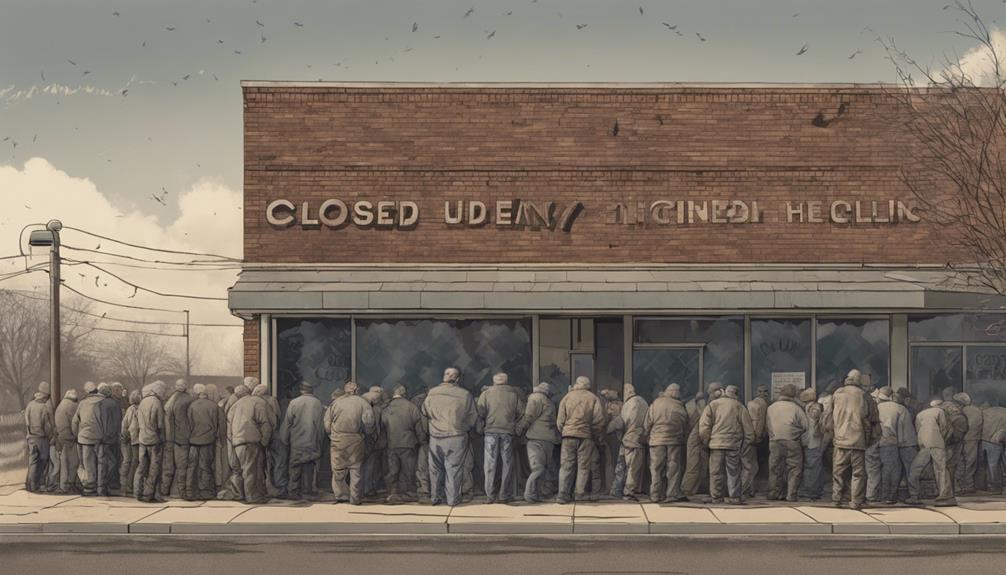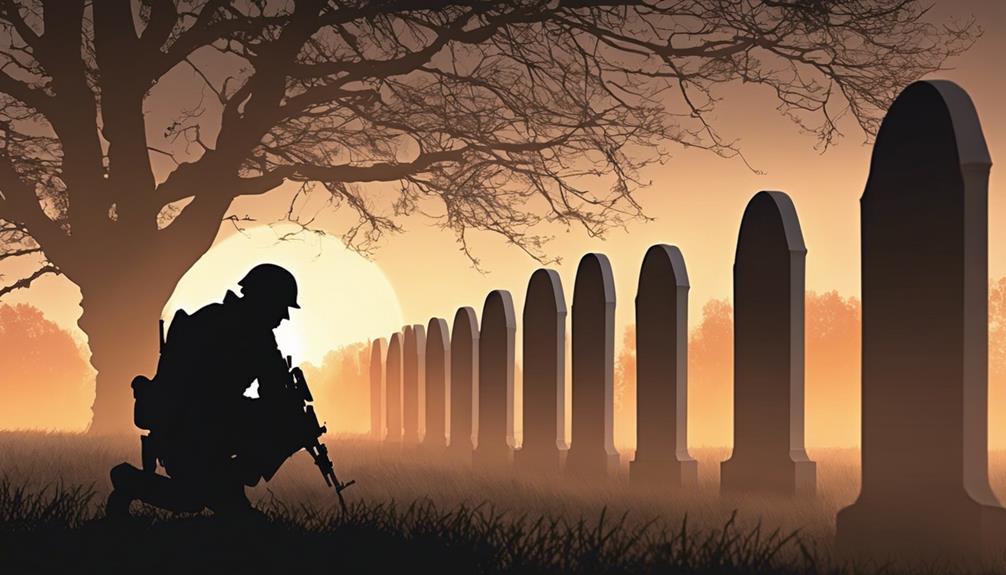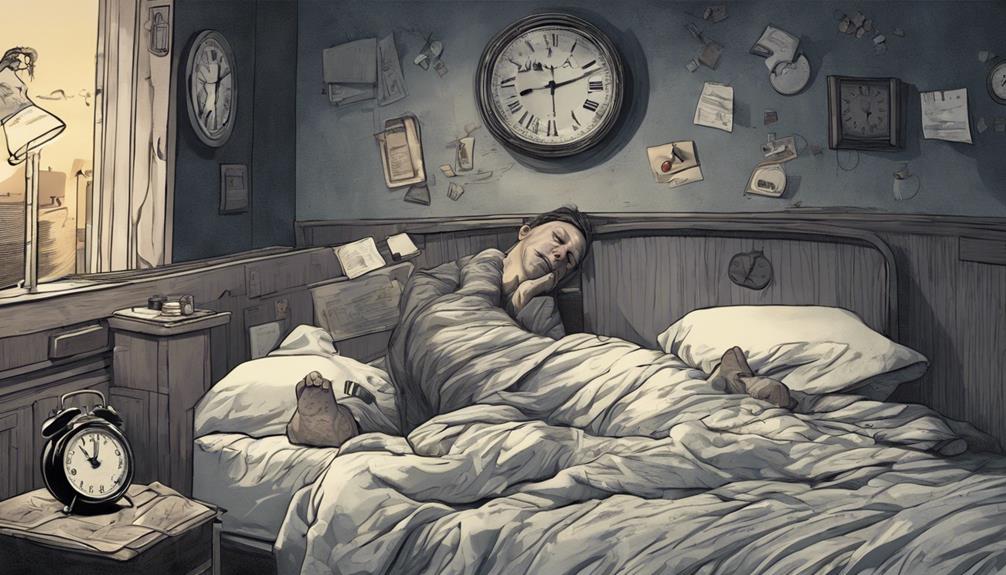In a world overshadowed by increasing feelings of despair, veterans are forced to navigate through their own battlefield filled with challenges from their time in the military.
The recent study sheds light on the grim reality of veteran suicide rates, a poignant reminder of the challenges faced by those who have bravely served.
As we explore the depths of this issue, it becomes increasingly clear that the solutions must be as robust as the problems they aim to address.
Key Takeaways
- Female Veterans show significant increase in suicide rates.
- PTSD and moral injury heighten suicide risk among Veterans.
- Limited mental health care access challenges Veterans' well-being.
- Comprehensive suicide prevention services and tailored mental health care are crucial.
Alarming Statistics on Veteran Suicide Rates
Investigating the alarming statistics on Veteran suicide rates reveals a sobering reality of the mental health crisis facing those who've served our country. In 2021, a staggering 6,392 Veterans lost their lives to suicide in the United States, highlighting the urgent need for effective suicide prevention strategies.
Suicide ranks as the 13th leading cause of death for Veterans, with it being the second leading cause for those under 45 years old. Notably, suicide rates among women Veterans rose by 24.1% in 2021, emphasizing the need for tailored interventions to address this concerning trend.
Legislation such as the CVSO Act, CAREERS Act, and the Daniel J. Harvey, Jr. and Adam Lambert Act aim to support suicide prevention goals for Veterans, but more comprehensive efforts are required. The Department of Veterans Affairs must prioritize implementing targeted programs to combat the increase in male Veteran suicides and work towards providing the necessary mental health support for those who've bravely served our nation.
Another study underscores the critical importance of addressing these alarming statistics promptly to safeguard the well-being of our Veterans.
Factors Contributing to Veteran Suicides

Examining the complex interplay of various factors sheds light on the underlying causes of veteran suicides. Veterans grappling with PTSD or moral injury face an elevated risk of suicide, emphasizing the critical need for mental health support. However, the lack of access to timely mental health care presents a significant barrier, leaving many veterans without the necessary resources. Financial constraints further compound this issue, hindering their ability to seek essential treatment. Additionally, veterans experiencing housing instability are particularly susceptible to suicidal thoughts, highlighting the interconnectedness of social determinants and mental well-being.
The high prevalence of firearms among veterans also plays a pivotal role in suicide rates, underscoring the importance of safe storage practices and awareness campaigns. Addressing these multifaceted factors necessitates a comprehensive approach that encompasses improving access to mental health services, financial assistance programs, and stable housing options. By recognizing and mitigating these challenges, we can work towards creating a supportive environment that promotes the well-being and safety of our veteran community.
Impact of PTSD on Veteran Mental Health
The impact of PTSD on the mental health of veterans is profound and multifaceted, influencing their overall well-being and daily struggles. Veterans with PTSD face a myriad of mental health challenges, from debilitating nightmares and flashbacks to constant hypervigilance, making it difficult to find moments of peace. These experiences often lead to feelings of hopelessness and isolation, further complicating their ability to cope with everyday stressors. The risk of suicidal ideation is significantly higher among veterans grappling with PTSD, highlighting the urgent need for effective treatment and support systems.
| Challenges of PTSD in Veterans |
|---|
| Suicidal Ideation |
| Feelings of Hopelessness |
| Social Isolation |
Addressing PTSD in veterans is crucial not only for their individual well-being but also for reducing the risk of suicide within this vulnerable population. By providing comprehensive and accessible treatment options, we can support veterans in navigating the complexities of PTSD and improve their quality of life.
Challenges in Accessing Mental Health Support

Navigating the complexities of accessing mental health support presents formidable obstacles for veterans, impacting their well-being and resilience. Here are some key challenges faced by veterans in accessing mental health care:
- Limited availability of mental health specialists: Veterans often face long wait times and a shortage of mental health professionals, delaying their access to crucial support.
- Trust issues from falsified medical records: Instances of falsified information by mental health providers can create distrust among veterans, hindering them from seeking the help they need.
- Lack of support systems within the VA: The absence of support structures like ombudsmen or advocates within the VA system adds to veterans' frustrations when navigating mental health care services.
- Need for peer support: Establishing support groups and promoting real-life interactions can enhance veterans' mental well-being by providing them with essential peer support, contributing to suicide prevention efforts.
Addressing these challenges is vital for improving veterans' access to mental health care and fostering a supportive environment for those who've served our country.
Strategies for Preventing Veteran Suicides
Facing the critical need for effective intervention, we explore targeted strategies for preventing veteran suicides and safeguarding the well-being of those who've served. Prevention is key in reducing the alarming increase in Veteran suicides. Implementing comprehensive suicide prevention services within the realm of Veteran health care is imperative. These services should address the unique challenges faced by Veterans, such as transitioning to civilian life, combat-related trauma, and the stigma surrounding mental health.
Lethal means safety programs can also play a crucial role in preventing impulsive acts of self-harm. The National Veteran Suicide Prevention program advocates for early intervention and support for Veterans experiencing suicidal thoughts. By enhancing access to tailored mental health care, we can potentially save lives and provide the necessary support for those who've sacrificed for our country.
It's essential to continue advocating for policies that prioritize the mental well-being of our Veterans and ensure they receive the care they deserve.
Frequently Asked Questions
What Is the Best Veteran Suicide Prevention Charity?
When seeking the best veteran suicide prevention charity, we prioritize proven effectiveness in crisis support for veterans. Charities offering tailored mental health services and strong partnerships with professionals stand out.
Transparency in donations usage and impact is crucial. We value evidence-based interventions aimed at reducing veteran suicide rates. Selecting a charity that aligns with these criteria ensures our contributions make a meaningful difference in the lives of those who've served.
What Is the Veteran Suicide Rate Study?
The veteran suicide rate study analyzed data from 2005 to 2011, uncovering 1,455 military personnel suicides. Army personnel showed the highest rates from 2006 to 2011. The study's goal is to enhance prevention strategies.
Data limitations include missing psychiatric and deployment history details. For instance, a hypothetical case study could involve a veteran struggling with mental health issues post-deployment. Understanding these trends is crucial for saving lives and improving support services.
What Does 22 a Day Mean?
When we talk about '22 a day,' we're referencing the heartbreaking reality that 22 veterans take their own lives daily in the U.S. This statistic underscores the urgent need for tailored suicide prevention strategies for veterans. Addressing the mental health challenges faced by those who served is crucial.
Our efforts must focus on understanding and combating the factors contributing to this tragic number, striving to reduce veteran suicides and offer the support they deserve.
Which of the Following Groups Has the Highest Rate of Suicide?
When determining which military group has the highest suicide rate, it's crucial to consider the unique challenges faced by each.
Infantry and special operations personnel, for example, have been identified as having a particularly high suicide rate. This group's preference for firearms as a method of suicide further highlights the need for targeted prevention strategies.
Understanding the specific struggles of different military groups is key to reducing suicide rates among our brave service members.
Conclusion
As we delve deeper into the harrowing reality of veteran suicides, we uncover a tangled web of challenges and missed opportunities.
Just like a ship lost at sea, our veterans are navigating treacherous waters with limited resources and support.
It's imperative that we band together, like a crew united in purpose, to steer them towards safer shores.
Let's not stand idly by while our heroes struggle, but rather extend a lifeline of compassion and understanding.









